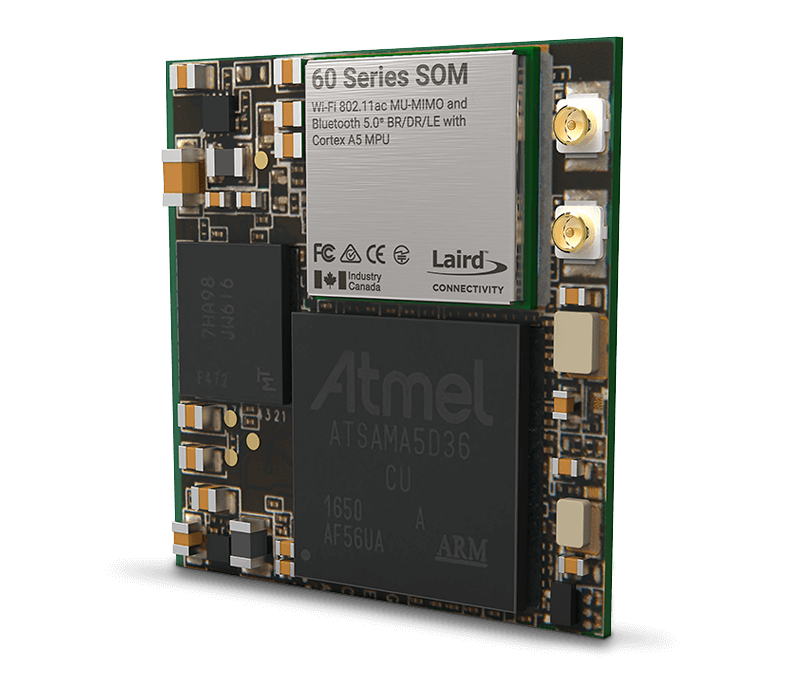
Designing an IoT Gateway with the 60 Series System on Module
Published on January 24, 2020

As we’ve previously discussed, building smart devices for the Internet of Things is largely centered around a handful of roles that have arisen in those applications. Generally they can be thought of as sensors/control points, gateways, and cloud servers. These are the tiers that make up the full ecosystem of devices in the internet of things: the devices at the ground level gathering sensor data and being controlled, the gateways that communicate down and up from the ground devices to the cloud, and the cloud itself where data is processed and where data is processed into meaningful information.
Ezurio (formerly Laird Connectivity) provides a wide variety of industrial-grade, high performance, secure wireless modules which are perfect for designing into IoT applications at the device and gateway level. We offer pre-designed gateways, standalone sensors, and modules which can be designed into any number of devices and gateways.
Today, we’re going to focus on our 60 Series System on Module, or 60-SOM. The 60-SOM is a complete Linux system on a board, which supports 802.11ac Wi-Fi, Bluetooth 5, two Ethernet connections, USB, SD Card, SPI/I2C, GPIO, and UART. Its not only packed with ways to connect, it features up to 2 Gb of LPDDR memory and 4 Gb of NAND flash memory, as well as a Cortex A5 MCU.
The 60-SOM is small and powerful enough to be integrated into any device with big wireless performance, and in this post we’ll discuss how the 60-SOM can be designed into a wireless gateway for IoT devices. We’ll also look at how to future-proof your devices for the applications that have yet to arise in your business.
An Example: IoT Quality Control on the Assembly Line
In a vehicle assembly environment, with multiple machines and personnel building cars with sequenced parts, a smart parts tracking system can be an invaluable secondary check on manufacturing processes. Each vehicle on the line has its own configuration, so it’s important to be sure that the correct parts are installed in the correct vehicles every time.
One way to verify these correct parts in the correct vehicle is using a barcode scanning system, to check the SKU of the vehicle and the SKU of the installed part as they pass by a fixed location. In this arrangement, a few wireless barcode scanners can be installed on the assembly line in the locations that the vehicle passes, to verify after installation that the required parts are in place.
The 60-SOM’s role here as a gateway is to collect this scan data, and verify it against a master list stored in the cloud. Once a vehicle’s build is specified and all its parts are sequenced, the 60-SOM can communicate over ethernet to retrieve that master list from cloud storage. As parts are scanned in the assembly environment, they can be transmitted via Bluetooth Low Energy to the nearby gateway, which contains the 60-SOM. The gateway can store and verify those scan codes against those expected from the master list.
In this design, mistakes in inventory sequencing or in installation can be identified and flagged, preventing costly downline repairs or, worse, a bad customer experience at the dealership. Up to seven concurrent devices can be connected over Bluetooth alone to a gateway, meaning a wireless gateway can support several secondary check stations within the facility, all reporting concurrently up to a cloud server. A log is maintained that documents when parts are installed correctly or not, and that log can be used to determine whether there is a high rate of error, and whether corrective steps are needed.
Designing for the Future: Your Evolving IoT Use Case
The 60 Series SOM features so many ways to connect that it’s useful in a huge number of IoT use cases. With multiple wired and wireless protocols, it’s easy to get data from a wide variety of sources, and in fact in most use cases, it would be difficult to utilize every single one. But the advantage to all of these interfaces is one that is impossible to fully anticipate – the direction that your use case will evolve over time.
Many businesses are just now beginning to develop their IoT applications, and it’s not clear yet the full extent of those use cases. But building a fully-featured gateway into your ecosystem is a great way to prepare for the demands of the future.
Right now, your wireless gateway might only be utilized for its Bluetooth, but changing circumstances could warrant adding Wi-Fi into your feature list. Maybe you find that in the environments where you’re operating, Ethernet is becoming the most suitable way to connect up to the cloud. Or maybe you’re finding that there’s a strong case for adding USB support for connecting extraneous peripherals.
Whatever the changing circumstances may be, what’s important is that a fully-featured module like the 60-SOM provides a base for your gateway that can grow with your changing development needs. By starting with your options wide open, you can safeguard your IoT design and avoid costly hardware redesigns in the future.
Ezurio – Your Full-Service IoT Partner
We don’t just provide best-in-class wireless modules and products to support your IoT designs – Ezurio provides in-house material and mechanical design, RF design, compliance and performance testing, and prototyping to accelerate your design to market. We have over 40 years in wireless product design, and our experts are among the best developers in the industry.
We’re a trusted partner that can identify problems before they impact your design and find the best way to bring your ideas to life. Learn more about our custom IoT development services , or learn more about our 60 Series System on Module.
 Laird Connectivity is now Ezurio
Laird Connectivity is now Ezurio